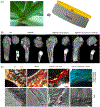Natural Medicinal Compounds in Bone Tissue Engineering
- PMID: 31882304
- PMCID: PMC8015414
- DOI: 10.1016/j.tibtech.2019.11.005
Natural Medicinal Compounds in Bone Tissue Engineering
Abstract
Recent advances in 3D printing have provided unprecedented opportunities in bone tissue engineering applications for producing a variety of complex patient-specific implants for the treatment of critical-sized bone defects. Natural medicinal compounds (NMCs) with osteogenic potential can be incorporated into these 3D-printed parts to improve bone formation and therefore enhance implant performance. Using NMCs to treat bone-related disorders may prove to be a healthy preventive choice as they are considered safe, have lesser or no side effects, and are more suitable for prolonged use than synthetic drugs. In this review paper, the current challenges of bone tissue engineering are addressed briefly, highlighting the immense potential of NMCs integrated within tissue engineering scaffolds for orthopedic and dental applications.
Keywords: 3D printing; bone graft substitutes; bone tissue engineering; drug delivery; natural medicinal compounds.
Copyright © 2019. Published by Elsevier Ltd.
Figures




References
-
- Younger EM and Chapman MW (1989) Morbidity at bone graft donor sites. J. Orthop. Trauma 3, 192–195 - PubMed
-
- Banwart J et al. (1995) Iliac crest bone graft harvest donor site morbidity. A statistical evaluation. Spine 20, 1055–1060 - PubMed
-
- Delloye C et al. (2007) Bone allografts: what they can offer and what they cannot. J. Bone Joint Surg. Br 89, 574–580 - PubMed
-
- Lord CF et al. (1988) Infection in bone allografts. Incidence, nature, and treatment. J. Bone Joint Surg. Am 70, 369–376 - PubMed
Publication types
MeSH terms
Substances
Grants and funding
LinkOut - more resources
Full Text Sources

